Objectives
Challenge your students to
investigate historical walls, both real and imaginary. Have them learn more
about cyclopean walls, the walls of
Jericho,
Constaninople walls,
the walls of Spain, the Berlin Wall, and any other walls they can discover.
Think about the purpose of walls throughout history, and consider the
alternatives available in today’s world to achieve the same purposes. Then
discuss the extent to which such barriers remain practical.
Publish work of your students in your school website and make sure to send us the
link.
Students will:
-
Research the history of
Walls.
-
Learn about events that
led to walls' construction and removal.
-
Build a webpage and
disseminate knowledge gained
Procedure
Discuss the history of the walls and fortifications with the class to assess
their knowledge of the subject. Send students on a web-hunt. Ask students to
locate information and answers to questions using the Internet.
For example:
Greece:
The Cyclopean Walls
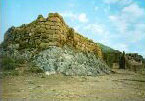 |
|
click on the image to enlarge |
|

<
click on the image to enlarge |
The fortresses of
Mycenae, Tiryns, and practically all other Mycenean settlements are
characterised by massive walls (usually 5 to 10m, 15 to 30 feet) thick and made
up of huge blocks of crudely shaped, and, in some cases, well finished blocks of
rock. This type of architecture is well seen at Mycenae. Please observe
the tremendous thickness of the walls, as well as the huge sizes of
the blocks incorporated within them. Note that the blocks at the top have been
stepped inward to produce a corbelled pointed archway. It is assumed that this
construction took place in the period between 1350 to 1325 B.C. These structures have survived
almost 4,000 years in one of the most earthquake-prone regions of the world.
Learn more about Mycenean walls:
www.culture.gr
China: The
great wall 
 |
|
click on the image to enlarge |
1.
What is the purpose of walls? Why did the Chinese construct them? How
important is it that the
Great Wall of China
has survived through the centuries and remains standing today? To what extent
does it serve as an icon for China?
2. Analyze the impact of
the Great Wall(s) of China on the course of western civilization. How would the
world be a different place if the Chinese had not constructed their walls?
Related
links: China art - Great Wall
http://pasture.ecn.purdue.edu/~agenhtml/agenmc/china/scengw.html
The Berlin
wall
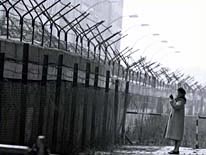 When was the
wall between East and West Berlin built? Why? When was the
wall between East and West Berlin built? Why?
-
East Germans fled to the
west, often in dangerous ways. Does this remind you of any other group of
people in history who have tried to escape inhumane treatment? If so, which
group?
What events led to the
wall's destruction? Can you explain why some former East Berliners would want
the wall to return?
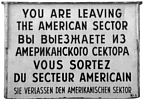 What is the East Side
Gallery? Who created it? When? Why are the wall and its art under threat? What is the East Side
Gallery? Who created it? When? Why are the wall and its art under threat?
Elaborate on the
possible reasons for artists to crusade for the preservation of a barrier that
was once a symbol of oppression. Do you think that the original art can be
duplicated? Why or why not? Is it a good idea to start from scratch? What do
you believe are the pros and cons of that option?
Learn more about the Berlin
wall:
1. A concrete curtain - Life and death of
the Berlin wall
http://www.wall-berlin.org/gb/berlin.htm
2.Newseum -Berlin Wall
http://www.newseum.org/berlinwall
Constantinople walls
|
 |
|
click on the image
to enlarge |
If city walls could talk, the Theodosian
Walls would be able to tell some of the most fascinating stories
from one of the world's oldest cities. The materials and methods used in their
construction reflect the monumental defence architecture of the period. In
some instances where parts of the walls have been repaired, the additional
materials have clearly been taken from other buildings.
Every gate has its story and reason for its name. The Edirne Kapi (once
Adrianople Gate) has changed, but the road that runs beneath the arch still
runs to the same place. It is thought that Mehmet the Conqueror entered the
city through the Adrianople Gate in the afternoon of May 29, 1453.
At one time the walls extended along the Sea of Marmara
and the Golden Horn. On the Sahil Yolu along the coast of the
Sea of
Marmara
some of the remains of the sea walls are still visible. Istanbul must have
been one of the most intensely fortified cities in the Medieval world. The
walls were a reflection of the strength of the city. For over a thousand years
they were able to provide effective, but ultimately not entirely impenetrable
protection for a glittering imperial capital. In essence, Istanbul, or
Constantinople as it then was, needed to be well fortified, as it had to
withstand more sieges than any other city. It was just as well the walls had
been built before Attila the Hun arrived at the gates of the city in 447 A.D.
Apparently he turned away and went in search of an easier victory over the
Byzantine Army on the Gallipoli Peninsula.
Spanish Walls
Nuria de Salvador (Spanish Spring Teacher) has
supplied us with information about Spanish Walls
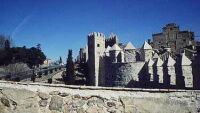 Toledo's
City Walls Toledo's
City Walls
Existing since the Roman times, in the year AD 674, they were reconstructed by
the Visigoth King Wamba. The remaining walls today, even though there are remains
of the Roman walls, are of Muslim origin that were finished by King Alfons IV.
An understanding king that upon entering the city conquered in 1,085, was
lenient with the ethnic minorities who granted them charters that were
consolidated by his grandson, King Alfons VII in 1,118. This permitted that
the three cultures, Muslim, Jewish and Christian, each with its values, lived
in unison enriching each other and that is witnessed all over this historic
city.
Walls of Cuenca
Built by the Moors in a
defensive position at the heart of the Caliphate of Cordoba, Cuenca is an
unusually well-preserved medieval fortified city. Conquered by the Castilians
in the 12th century, it became a royal, bishopric
town endowed with
important buildings, such as Spain's first Gothic cathedral, and the famous
casas colgadas (hanging houses), suspended from sheer cliffs overlooking
the Huicar river. Taking full advantage of its location, the city towers above
the magnificent countryside.
Walls of Tarragona
They are built between the Roman Walls and the wall built in the XVIII century
during the Succession War, and they allow passersby to see a beautiful
view of
the city of Tarragona and also of the Camp de Mart.
The Roman Wall, was built in the III century B.C. with a giantic base formed
by big stone blocks with some doors. These doors have been moved with the time
such as the Roser's doorway or Saint Antoni's doorway which were built in the
XVIII century. These doors connect this part of the city with the old part of
the city.
The original Roman Wall structure has been modified through the ages by the
buildings made nearby. During the last years some measures have been adopted
in order to preserve the Roman Wall because environmental conditions such as
pollution, humidity, etc., were endangering it.
Nuria also
gathered
information about these walls in
Spanish
Valentina
Cuadrado and her students have created a beautiful page about
Avila Walls
Suzanne
Pratcher (Spring teacher of Austria) reminded us of these walls:
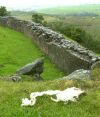 1) Hadrian's
Wall (between England and Scotland), which is a World Heritage Site 1) Hadrian's
Wall (between England and Scotland), which is a World Heritage Site
http://www.hadrians-wall.org
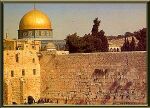
2) The Wailing Wall in Jerusalem
http://www.us-israel.org/jsource/History/wallname.html
 3) The very controversial wall which is built by the Israeli government
between the Jewish and Palestine settlements 3) The very controversial wall which is built by the Israeli government
between the Jewish and Palestine settlements
e-mail us at:
primavera2004@sch.gr
|